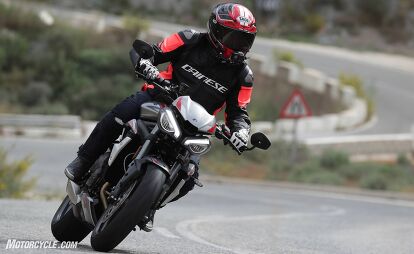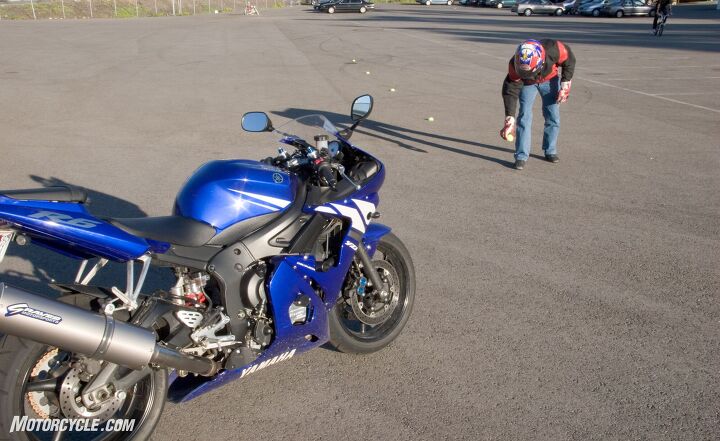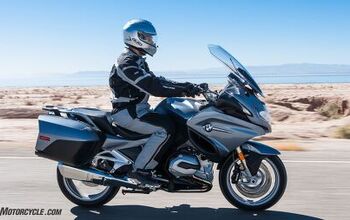How To Countersteer A Motorcycle

Yes, it's counterintuitive
Part of the fun of riding motorcycles comes from the mastery of controlling an unstable machine. Without their riders, motorcycles can’t stand up by themselves at a stop. When it comes to riding motorcycles, being able to precisely place your motorcycle where you want it on the pavement comes from practice and understanding how motorcycles turn. That technique is countersteering.
During the seminal 1981 Hurt Report, which is officially titled Motorcycle Accident Cause Factors and Identification of Countermeasures, the accident study’s findings noted, “Motorcycle riders in these accidents showed significant collision avoidance problems…. The ability to countersteer and swerve was essentially absent.” In fact, in some cases, the riders actually steered their bikes into the object they were trying to avoid. While we can’t avoid the fact that target fixation probably played a role in some of these instances, the Hurt Report indicated that many accident-involved motorcyclists didn’t know how to properly countersteer.
So, what is countersteering? The simple definition is that you turn the handlebar in the opposite direction of the way you want to turn. Want to go right? Turn the handlebar to the left. This counterintuitive turning process illustrates why it is so important to learn countersteering. Simply put, riders who don’t completely grasp countersteering – down to the muscle-memory level – run the risk of crashing themselves into the car, truck, pothole, deer, or pedestrian they want to avoid. (For a great example of this, watch the slow-motion section of the video below. You can see him try to steer the bike away from the truck and actually wrestle with the handlebar.)
On more than one occasion, back when I was a motorcycle safety instructor, I was challenged over countersteering by “experienced” riders who brought their wife/girlfriend/teenaged offspring to take the course. In those instances, I told them to try a simple exercise on their ride home. Ride down the street going fast enough to stabilize the bike, place the palms of their open hands on the grips, and press forward with one of the hands – and tell me what happened when they saw me next. Some actually came back amazed at how it worked, leading to a fun discussion of how they had always been countersteering subconsciously, but now, they had a new tool to use in crash-avoidance situations. The others just avoided me to their detriment (IMO).
What’s happening when you turn the handlebar to the left – or press forward on the right grip – is both quite simple and really complex. Being a single-track vehicle, the front and rear wheels follow the same track when traveling in a straight line. When you press right/turn left, the front wheel moves to the left of that single track. Since the bike’s inertia wants to try to continue in the previous straight line, the bike pivots around its center of gravity in its attempt. The result is the bike is leaning to the right, and we know that you make motorcycles turn by leaning them. (There are other forces in play during countersteering, like gyroscopic precession, which is comparatively minor. So, I’m leaving that out. If you want to go down the rabbit hole on all the physics involved in turning a motorcycle, there is a chapter devoted to it in Tony Foale’s Motorcycle Handling And Chassis Design.)
Countersteering is simply a very efficient means of making a motorcycle lean. So, how do we make it work for us? The mnemonic “press right, go right” is a great way to commit the idea to memory, but the key is to practice consciously countersteering. Riding down the road you can dodge the dotted white line when it’s safe. You can practice swerving to avoid painted directional markings in your lane. If you want to go all out, set up a cone weave in an empty parking lot.
Keep working on your countersteering until it becomes second nature. I can guarantee that it will save your hide at some point in your riding career.

Like most of the best happenings in his life, Evans stumbled into his motojournalism career. While on his way to a planned life in academia, he applied for a job at a motorcycle magazine, thinking he’d get the opportunity to write some freelance articles. Instead, he was offered a full-time job in which he discovered he could actually get paid to ride other people’s motorcycles – and he’s never looked back. Over the 25 years he’s been in the motorcycle industry, Evans has written two books, 101 Sportbike Performance Projects and How to Modify Your Metric Cruiser, and has ridden just about every production motorcycle manufactured. Evans has a deep love of motorcycles and believes they are a force for good in the world.
More by Evans Brasfield

































Comments
Join the conversation
This list of proof illustrates no CS occurs with two-wheelers. Why is the CS myth so common? (Links are not allowed, see them at Y.T.)
Bike riders don't STEER or counter steer for turns! LEAN, otherwise you break the cardinal rule of bikes, STAY BALANCED.
Thankfully, the bike is designed to STEER for you, at speed, whether your riding straight or in an inclined turn. Handlebars are simply LEVERS, (not a steering wheel), for degrees of rotational torque for turns, and changing the incline angle, as needed. Rider steering is only done for balance, at very slow speed.
ZLATKO DJUKIC TURNS WITH NO HANDS,
PROVING RIDING CONTROL BY LEAN ONLY:
https://www.youtube.com/wat...